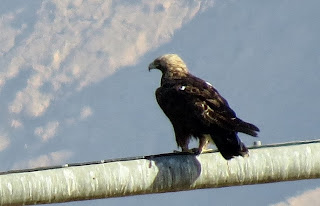two Caspian plover
The biggest highlight there and also of the whole weekend trip was the discovery of 14 Caspian plover at the edge of a fodder field.
Saudi Arabia is on a direct line between their central Asian breeding grounds and their known wintering grounds in East and South East Africa.
However there are two main reasons why the sighting was a shock albeit a very pleasant one. First, conventional wisdom has it that they should all be in East Africa by now. Second they are much more rarely seen in "autumn" than in spring. Some people reason that they fly directly in autumn over the Middle east without stopping.
Caspian plover takes off
Both of those hypotheses are looking a bit shaky. Either way, seeing them were moments to enjoy.
The birds hardly moved in all the time Lou Regenmorter and I observed them leading us to believe they were either tired or sated.
They were not fazed by our presence. Indeed we left them without them flying off only to see the water sprays on the field's pivot bar disturb them minutes later.
4 out of 14 Caspian plover
Caspian plover is the 314th bird on my Saudi list which is getting increasingly difficult to add to.
Eastern imperial eagle
There was more to these fields than Caspian plover.
The fields nearest the escarpment held the occasional eagle. Most eagles were steppe eagle though two Eastern imperial eagle were also observed.
steppe eagle
Harriers in the fields were even more common. Although there were a small number of marsh harrier, the more common bird was pallid harrier.
marsh harrier
There was a high proportion of adult males among the pallid harrier too.
Steppe eagle with pallid harrier
Another feature of the fields was the very large number of wintering wheatears. In the southern farms most were northern wheatear. Incidentally northern wheatear does not winter in the Riyadh area, 650 kilometres north east.
Isabelline wheatear
The bird above is identified as an Isabelline wheatear (rather than northern wheatear) primarily because the supercilium is broadest and whiter in front of the eye.
desert wheatear
Another feature of the fields were the huge numbers of flocking house sparrow. In this area at least no Spanish sparrow were among them.
Larks were extremely common and flocking too. These were all apparently crested lark and greater short toed lark.
house sparrow
Once again on one of our trips, we picked up a group of cream-coloured courser. I have now seen them in many parts of Saudi Arabia. As well, as in natural surroundings, they are often seen on arable fields with low level or very low level vegetation. Here we saw eight of them in a newly sown field which was being watered.
cream coloured courser
Other notable birds present were Asian grey shrike (aucheri) formerly designated southern grey shrike.
Asian grey shrike (aucheri)
Actually this area had the highest density of this shrike that I have seen in Saudi Arabia.
Tawny pipit
The pipit family was represented by tawny pipit and white wagtail though the numbers weren't as high as in the Riyadh area.
The picture of the tawny pipit was taken through the car window because some parts of the area were literally thick with flies. It was better to stay in the car with the windows up. The flies were non-biting but still a real nuisance and we couldn't work out where they were coming from.
white wagtail
I always try to look out for other wildlife on our trips. This time a type of fox was seen on different occasions.
fox
Obviously, I was very pleased about the Caspian plover but there were other surprises in the area just to the north of the southern farms and in Sulayyail too. The next two blogs will cover these areas and birds.
















Rob,
ReplyDeleteExcellent records of the Plovers. There have been records in November from the Eastern Province where 30 were seen in the Dibdibah plains in the north in November 1983 (long time ago). Jennings checklist of birds of Saudi Arabia 1981 says they are an uncommon migrant to Central and Eastern areas that are apparently more common in the west but probably mistaken identity accounts for this claim. There are certainly few records from the west of Saudi Arabia in recent years.
Jem
Jem, why I think they might be staying is because this was the very end of November (29th) and the climate, latitude and terrain in wadi dawasar is similar to parts of east Africa.
ReplyDeleteSounds like a brilliant weekend Rob, well done on 314, it may be slowing but your getting there!
ReplyDeleteThanks Bernard. It was not a bad weekend at all. Lots of birds seen which are normally expected further south and west.
ReplyDelete